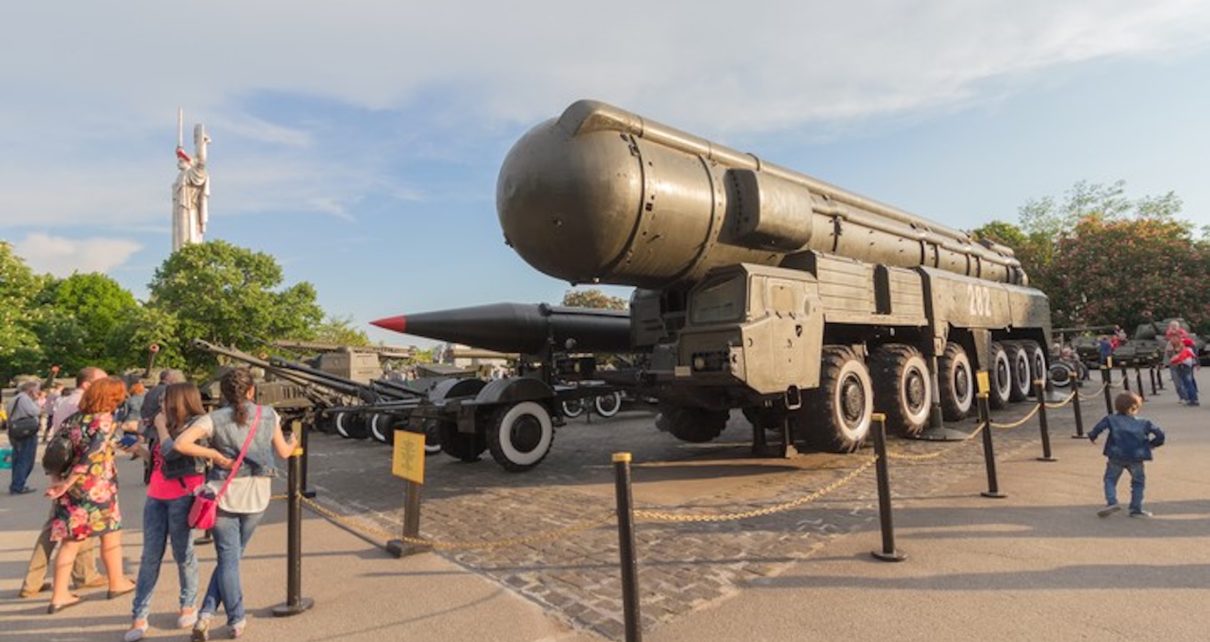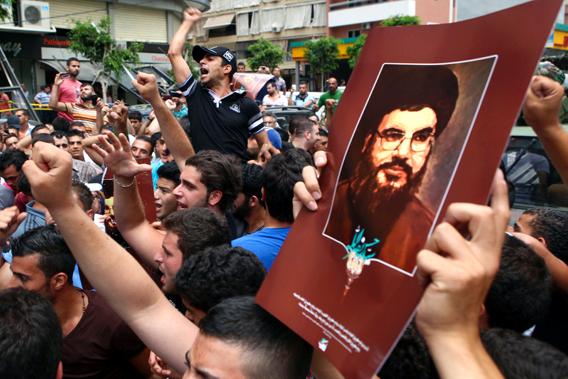Although there are no longer INF Treaty restrictions on the deployment of ground-launched intermediate-range missiles, and concerns about their deployment in Europe loomed large in the diplomatic brinkmanship leading up to the full-scale Russian invasion of Ukraine in February, 2022, land-based INF-range missiles have yet to play a role in the Russia-Ukraine War.
The scope of the INF Treaty has much to do with this. The treaty was not a typical arms control agreement, most of which set numerical limits on weaponry. Instead, the INF treaty eliminated ground-launched conventional and nuclear missiles within ranges of 500 and 5,500 kilometres as an entire category of weapons. That feature of the treaty continues to shape the post-INF security environment; none of the actors in the war have been able to scale up post-INF capabilities.
Daggers Out
The United States withdrew from the INF Treaty in 2019 after accusing Russia of fielding a ground-launched cruise missile (GLCM) with an estimated maximum range of 2,500 km. Assigned the NATO reporting name SSC-8 Screwdriver, Moscow denied that the GRAU-indexed 9M729 missile violated the treaty, insisting that its range falls below the INF Treaty’s 500 km threshold.
Judging from open source information, it does not appear that Russia has used the SSC-8 in strikes against Ukrainian targets. If the SSC-8 remains unused, it might be because Russia’s military command is holding the missile in reserve for contingencies related to NATO involvement in the war, especially as Russian missile stockages dwindle. Pre-war estimates of the number of battalions armed with SSC-8 delivery systems range from only two to four stationed at various locations in Russia.
So far, Russia has fielded missiles that fell outside INF Treaty restrictions, like the Iskander (NATO name: SS-26 Stone). This short-range ballistic missile system owes its existence to the restrictions in the INF Treaty. The Iskander is the successor to an earlier weapon, the 900 km-range OTR-23 Oka theatre missile system (SS-23 Spider), which was dismantled after Mikhail Gorbachev agreed to extend INF Treaty restrictions to shorter-range land-based missiles with ranges between 500-1000 km. The Iskander has a maximum range just below the INF Treaty’s 500 km threshold.
The INF Treaty never imposed restrictions on intermediate-range missiles launched from aircraft, ships or submarines, the treaty’s concern being the land-based missile balance between NATO and the Warsaw Pact in the Cold War. Russia has resorted to widespread use of intermediate-range missiles launched from aircraft and naval vessels. These include strikes on critical infrastructure with air- and sea-launched intermediate-range missiles like the Kh-47M2 Kinzhal or “Dagger” (AS-24 Killjoy) and the 3M-54 Kalibr family of land-attack cruise missiles (SS-N-27 Sizzler and SS-N-30A).
He Whose Ship is Sunk, Lay Blame on Neptune
Ukraine saw the termination of the treaty as an opportunity to declare its intention to develop its own intermediate-range missiles. President Petro Poroshenko stated in 2019 that, since Ukraine was no longer bound by INF Treaty restrictions following Russia’s non-compliance, new missiles were “on the agenda.” Ukraine’s National Security and Defence Council announced the following year that Kyiv would develop a missile with a range over 1,500 km.
Despite these pronouncements, only short-range missile development projects bore fruit before Russia’s full-scale invasion of Ukraine in February, 2022. The R-360 Neptune land-based anti-ship cruise missile, which has a range of approximately 300 km, is believed to have hit the Russian Navy frigate, Admiral Essen, and sunk the Moskva battle cruiser. Also manufactured domestically was a 120 km range ground-launched multiple launch rocket system (MLRS) called the Vilkha-M (“Alder”). Modeled on the Soviet-era BM-30 Smerch MLRS, the Vilkha-M underwent testing through 2020 and was scheduled to be produced en masse in 2021. Whether this missile system made it to the battlefield is unclear, judging from open source information. The Russian Ministry of Defence claims to have destroyed Vilkha-M missile launchers.
Aside from domestically-produced rocket and missile systems, the longest range surface-to-surface missile in Ukraine’s arsenal is the Soviet-era Tochka-U (SS-21 Scarab), a tactical ballistic missile system that was not affected by the INF Treaty because of its 100 km range. There are reports that a Ukrainian SS-21 hit Russian targets early in the war, including targets on the Russian side of the border.
Rocket artillery systems have been vital to Ukraine’s campaigns in the south and east of the country. The American High Mobility Artillery Rocket System (HIMARS), for example, enabled Ukraine to disrupt Russia’s operational rear with deep strikes on high-value targets, like command posts and ammunition depots. The U.S. Ground Launched Small Diameter Bomb extends the range of Ukraine’s HIMARS, but only to 150 km, while the British- and French-supplied Storm Shadow/SCALP-EG stand-off air-launched cruise missiles only extends to a range of approximately 250 km. In a statement to the U.K. Parliament, Defence Secretary Ben Wallace noted that the ranges of the Russians’ Killjoys and Kalibrs are approximately “7 times that of the Storm Shadow missile.” The extended range U.S. Army Tactical Missile System (ATACMS), if provided to Ukraine, would still be below INF levels.
The Commander-in-Chief of the Armed Forces of Ukraine, Gen. Valeriy Zaluzhnyi, described the disparity in missile target coverage between Ukraine and Russia. “For the Russian armed forces,” he stated, “it’s up to 2,000 km, taking into account the range of air-based cruise missiles [like the Kinzhal], while for Ukraine’s forces it is actually a mere 100 km, which is limited to the range of missiles and the deployment depth for the outdated short-range ballistic missile systems [e.g. the Tochka-U].”
This summer, Ukraine renewed its plans to produce intermediate-range missiles. Then-Defence Minister Oleksii Reznikov made the announcement, stating that there are “very good prospects” that the country can produce missiles with a range over 1,000 km. There was no indication from news reports as to whether the missile will be ground-, sea-, or air-launched.
Sabers and Screwdrivers
The other INF angle of the war relates to NATO. The United States dismantled its ground-launched theatre missiles as part of the INF Treaty implementation. French and British ground-launched INFs were not subject to the treaty and are no longer in service.
In the years leading up to Russia’s full-scale invasion of Ukraine, NATO had pledged to counter the SSC-8 through measures short of fielding its own intermediate-range missiles. Such forbearance is likely a thing of the past. With the war raging in Ukraine, new members joining NATO on its eastern flank, and munitions shortfalls beginning to pinch, NATO will likely consider matching the SSC-8 with a counter-deployment of its own, as it did in the late 1970s when the North Atlantic Council announced plans to field modernized INFs in response to the Soviet RSD-10 Pioneer (SS-20 Saber), a missile system with multiple warheads and a range of up to 5,000 km. Policy-makers’ concerns about precipitating another Euromissile Crisis, like the one that convulsed public opinion in NATO member-countries in the 1980s, probably will be subdued this time around.
Moscow is unlikely to return to the status quo ante of INF Treaty compliance, despite its pre-war diplomatic efforts to secure a freeze on missile deployments in Europe. The resource drain of the war in Ukraine, coupled with the wider geopolitical environment vis-à-vis NATO and the military balance in the Indo-Pacific region will leave Russia hesitant to part with a capability like the SSC-8 anytime soon. The Soviet and Russian defence establishments never came to terms with the INF Treaty in the first place, considering it foolhardy for a land power as vast as Russia to relinquish ground-based missile delivery systems while France and Britain retained theirs, countries near Russia’s borders built medium-range missiles of their own, and the United States compensated for reductions in ground-based missile launchers with air- and sea-launched missile systems.
In America, there were signs of a change in approach to ground-launched intermediate-range missiles even before the Russia-Ukraine War. Not long after withdrawing from the treaty, the U.S. military tested a prototype intermediate-range GLCM. And a few months before the war, the U.S. Army reactivated its European artillery and rocket command, which was disbanded after the signing of the INF Treaty.
When Mikhail Gorbachev, one of the architects of the INF Treaty, passed away last August, a commentator observed that the Russia-Ukraine War would be far more dangerous than it already is if ground-based missiles with ranges that put most of Europe’s cities at striking distance were part of the military equation. If the Russia-Ukraine War drags on for years, ground-launched intermediate-range missiles will likely be part of that equation.
Photo: SS-20 Saber Soviet IRBM (2016) via Credit: DmyTo via iStockPhoto.
Disclaimer: Any views or opinions expressed in articles are solely those of the authors and do not necessarily represent the views of the NATO Association of Canada.




